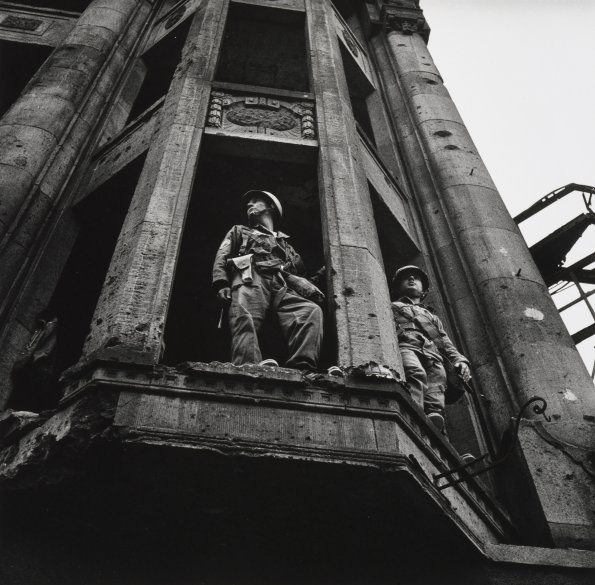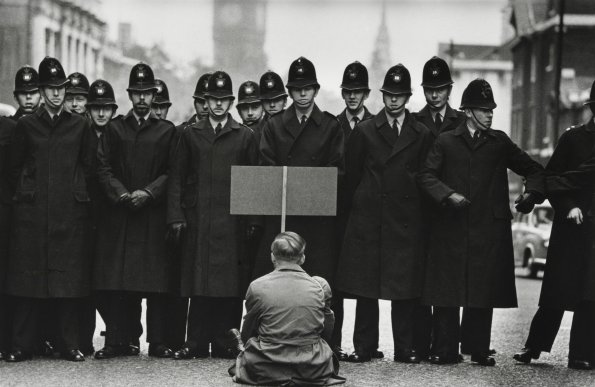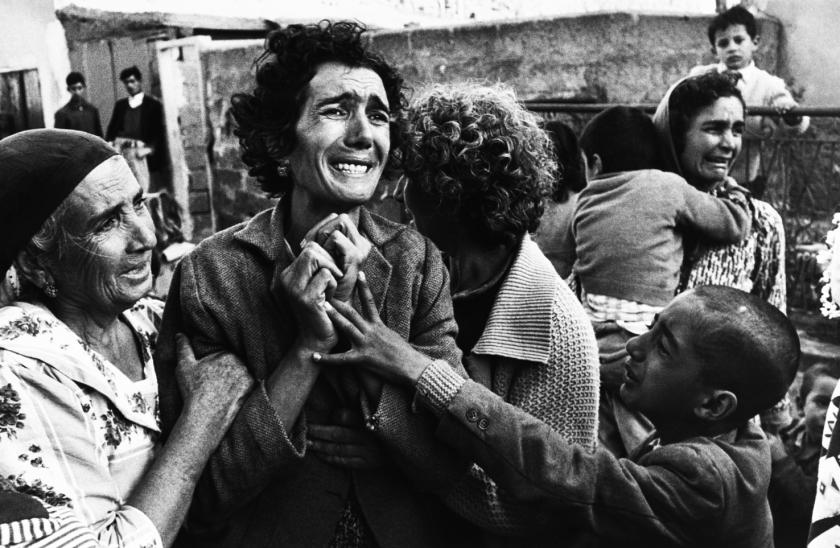Armed American soldiers stand in the stone window frames of a ruined building in Berlin, curious and disturbing echoes of those classical statues that so often were used to add portentous significance to a facade; but here in a 1961 photograph by Don McCullin, they are overlooking, with some intensity, the East German military on the other side. The Wall has just been built.
Chronicling another painful divide in 1964, McCullin photographed a distraught, silently screaming widow, a Turkish Cypriot victim of that civil war, as she is restrained and held by other women, in an oddly dignified frozen tableau.
In a 1968 photograph a US Marine pauses for thought, inadvertently echoing those Renaissance paintings of meditating scholars, holding his helmet rather than a book, but this is a quiet moment in the battle for Hue. It is McCullin’s photographs which helped to define the savage war in Vietnam for Britain and beyond. Some are unbearably sad: a young North Vietnamese soldier, a casualty of Hue, stares sightlessly at the photographer, his hands outstretched to the detritus of his pockets, scattered on the earth beside the body - bullets, and photographs of his family, wife and babies.
These photographs in the main were taken to be published, not hung on gallery walls
For a substantial part of his later career McCullin has gone beyond armed conflict to record the consequences of other calamities: a mother holds her terrified wailing child close to her breast in an attempt to soothe and comfort at the time of the devastating cholera epidemic in Bangladesh in 1971. It was the cover photograph of a story subtitled "A Land Beyond Comfort", which reported on the painful consequences of the birthpangs of East Pakistan.
These photographs in the main were taken to be published, most notably in the pages of Harry Evans’s Sunday Times, or rather its pioneering magazine with its gifted picture directors, and not hung on gallery walls. Yet here, scores of photographs, immaculately printed up at a size three or four times that of the printed page, framed and arranged with succinct text, are magnificent.
There is, of course, a long lineage of suffering made beautiful. Think of Titian’s Flaying of Marsyas, and the endless Renaissance depictions of saintly martyrdoms. Certainly the search for the aesthetic was not McCullin’s intention, yet a terrible beauty is characteristic of much on view, lending a sense of disquiet and intensifying the visitors’ experience. (Pictured below: American soldiers on high alert monitor East German forces from an upstairs window at Friedrichstrasse in Berlin, Germany, 1961.)
 Among the many unassuming gifts McCullin brings to his camera’s eye is the dignity he bestows on his subjects. The exhibition is set out like an accessible maze, divided into various chronological chapters, and intelligently varied so as to avoid that endless procession of black-and-white rectangles that normally make photography exhibitions so dispiriting, when physical repetition wears down the viewer’s attention.
Among the many unassuming gifts McCullin brings to his camera’s eye is the dignity he bestows on his subjects. The exhibition is set out like an accessible maze, divided into various chronological chapters, and intelligently varied so as to avoid that endless procession of black-and-white rectangles that normally make photography exhibitions so dispiriting, when physical repetition wears down the viewer’s attention.
McCullin’s acerbic and acute eye, his brave vision, did not flourish in the 1980s. After openly criticising the new regime at The Sunday Times he was sacked, but in the law of unintended consequences new vistas opened up: not only photographing for aid charities, but also the remnants of the long-lost Roman empires in Africa and finally his own still lifes and landscapes.
There is a final space devoted to the Somerset landscapes that surround his home, printed in the silvery black-and-white he prefers. McCullin is quoted as saying that his “landscapes have become a form of meditation. They’ve actually healed a lot of my pain, my guilt, from the things I’ve seen”. It is the classic dilemma of the observer, that he who brings the news does not and normally cannot intervene.
There is also a remarkable series of domestic still lifes, in which arrangements combine flowers and souvenirs from South-East Asia in piquant juxtaposition.
The Imperial War Museum is the great museum of 20th and 21st-century history, and here we have several decades' worth. McCullin, dyslexic, is sharply articulate: there is an excellent filmed interview (its cameraman is from the British Army, serving at the fronts of both Afghanistan and Iraq) in which McCullin acerbically points out that the media did not lose the Vietnam War for the Americans: the North Vietnamese won it.
The exhibition is the largest there has ever been of McCullin’s work and starts with his earliest published photographs, that of gangs in north London (yes, they had gangs, riots, poverty and social unrest all those years ago, unrest was not invented in Tottenham), and then his self-generated visit to Berlin just as the Wall went up in 1961. Many large-format prints are used here for the first time, and many have been especially printed for the occasion by McCullin. There is memorabilia, including the Nikon camera, an unwitting shield, that took the bullet that might have added McCullin to the casualties of war reportage. Pages from various newspapers including the pioneering photo-essays in The Sunday Times Magazine give the visitor a sense of how the photographs were actually used. (Pictured below: Alone anti-war protester confronts police in Whitehall during the Cuban Missile Crisis, London, 1963.)

The people McCullin shows us are ordinary people caught up in overwhelming events: pushed to the extreme, traumatised, exhausted, fearful and courageous. The shock of recognition is how much Don McCullin’s eye has informed us all, how much we visualise recent history through the lens of McCullin’s camera. This anthology shows us a gifted practitioner who has transformed reporting into art, impressing the results into our collective visual memory.
- Shaped by War: Photographs by Don McCullin at Imperial War Museum, London until 15 April, 2012









![SEX MONEY RACE RELIGION [2016] by Gilbert and George. Installation shot of Gilbert & George 21ST CENTURY PICTURES Hayward Gallery](/sites/default/files/styles/thumbnail_125_x_125_/public/mastimages/Gilbert%20%26%20George_%2021ST%20CENTURY%20PICTURES.%20SEX%20MONEY%20RACE%20RELIGION%20%5B2016%5D.%20Photo_%20Mark%20Blower.%20Courtesy%20of%20the%20Gilbert%20%26%20George%20and%20the%20Hayward%20Gallery._0.jpg?itok=3oW-Y84i)





Add comment